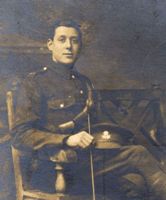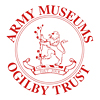
Photograph of Harry in Tameside Local Studies and Archives Centre. Reference: MRP/4F/049

(L to R) 1914-15 Star; British War Medal; Allied Victory Medal
Harry was born on Christmas Eve 1894 in Leigh, Lancashire. He was baptised as a member of the Wesleyan Church on the 17th March 1895. His father's name was George and his mother was Jane Ann. He was their oldest child, and the only boy. His younger sisters were called Harriet, Lillian, Charlotte Annie and Mary Alice.
His parents had lived at 42 Selwyn Street in Leigh when Harry was born. They were still here in April 1901, when George worked as a cotton stripper. Sadly Lillian died that September, aged just 8 months.
By 1911 the family had moved to 14 Tunnicliffe's New Row. George was now a grinder in a cotton mill, and Harry had followed his father into the industry. He was working as a scavenger. Mary Alice died aged 5 on the 29th August 1912.
When the First World War broke out in August 1914 Harry was one of thousands of young men who wanted to do their part. He enlisted in Leigh on the 7th September 1914. He was 5 feet 7 inches tall and weighed 121 pounds. He had a 'fresh' complexion, with grey eyes and brown hair.
Harry enlisted for General Service. This meant he could be sent to any unit that needed men. He was posted to the 10th (The Prince of Wales's Own) Royal Hussars, a Cavalry Regiment, and was given the service number 28310.
Harry trained at the Northern Cavalry Depot in Scarborough. On the 2nd December he finished training and was transferred to the 13th Reserve Cavalry Regiment, based in Colchester, where he would wait to be sent overseas.
Casualties amongst the cavalry had not been high, but the Army needed more infantry. Because of this Harry was transferred to the 16th Battalion of the Manchester Regiment on the 30th April 1915 at Belton Park near Grantham in Lincolnshire. His service number became 7698. Before he was transferred Harry either bought or was given a silver wrist watch engraved with 'Harry Ball, 10th Hussars'.
Harry joined A Company of the 16th Battalion, under the command of Hubert Worthington, whose medals are also in the Museum of the Manchester Regiment collection. Hubert 'first met him on the range at Salisbury Plain where his charming young personality at once endeared him to all, and he incidentally proved himself the best shot in a fine Company'.
The battalion sailed to France on the 8th November. Harry became his Platoon's runner, or messenger, and worked closely with Hubert.
The Somme Offensive began on the 1st July 1916. The 16th Battalion attacked the village of Montauban. They took heavy casualties but broke through the German trenches and 'were all full of exhilaration and the joy of battle and the certainty of success'.
In a letter to Harry's parents Hubert described what happened to him. He had delivered a message ordering his comrades not to advance until 'the artillery barrage lifted' and was returning to Hubert 'under a murderous machine gun and shrapnel fire' when 'I saw him totter and without a sound, fall to the fresh grass. I saw that his hand was hit, and his heart, or thereabouts, and I dashed to try and catch him... Just as I reached him 6 machine gun bullets hit me'.
Hubert was certain Harry had 'laid down his life for his friends'. The Army, however, listed him as missing and tried to find out what had happened to him.
At some point between July and October George and Jane 'received some photographs from a wounded soldier which was belonging to our son and he said he picked them up besides a dead soldier'. The wounded man was Private 16511 Robert Cochran, of the 13th Battalion the Royal Scots (Lothian Regiment).
George and Jane went to see him in hospital in Leeds on the 21st October and he told them that he had found the photographs on the 3rd July. Robert 'could not say for certain that it was our son'. Harry had been wounded in the right arm, and Robert had seen a wound on the dead soldiers arm, but 'he could not say' which one. George and Jane asked about Harry's watch, but without success.
On the 24th May 1917 the Army decided Harry had died on the 1st July, aged 21. His parents remembered that 'he never gave us any trouble since he was born', and Hubert felt this was 'a fitting memorial to a noble life'.
Harry's body was never found, so his name is listed on the Thiepval Memorial in France along with 72,202 other soldiers. Harry is on Pier 13 Face A or Pier 14 Face C. His medals were donated to the Museum of the Manchester Regiment in April 2009.




